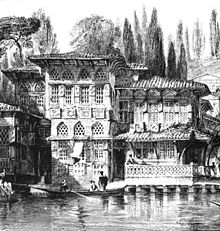Yalı
As Yalı ( Ottoman يالی), Turkish plural yalılar, refers to summer villas and residences that were built in wood, mainly on the banks of the Bosphorus near Istanbul . A fairly flat, widely overhanging roof is typical. Yalıs were surrounded by gardens and usually had a boat dock.
Characteristics of the Yalılar
Yalılar were basically built of wood. Only the foundation and quay walls are made of stone. The lightweight two-storey wooden construction has the advantage that there is a certain resistance to earthquakes on the one hand and to the moisture penetrating from the Bosporus on the other. A yalı usually has high rooms with numerous windows. This is due to the fact that the Yalılar served as summer houses for wealthy Ottomans , who often also had a city palace ( Konak ) and another Köşk on the Prince Islands or on the Marmara Sea . The summer temperatures were also counteracted by flat, wide cantilevered tile roofs .
Due to their location, the Yalılar mostly have their own boathouse or mooring.
Many of the Bosporus villas have not been family owned for generations. The reason for this was that the timber construction was very expensive to maintain, so that z. B. the vizier could only perform a Yalı while he was in office. After a change of ownership, the house was often demolished and rebuilt to the taste of the new owner. This is not the only reason why the Yalıs have always been particularly threatened.
Inside the Yalılar there are usually large, cross-shaped central halls. These always lead to the Bosphorus on one side and to the park-like garden on the other. In the middle of the marble-clad hall there is often a fountain , vaulted by a dome hidden under the roof. The ceilings of the living rooms, which are divided into harem and selamlik , are always decorated with painted wood carvings. Walls, doors and cornices also attract attention in this way.
The traditional Yalılar are surrounded by magnificent gardens, in which pine and palm trees next to magnolias , wisteria and Judas trees make the stay a pleasure.
History of the Yalılar
The first depiction of yalı-like riverfront houses dates from around the year 1000: Uyghur painters depicted paradise as a series of yalılar. The construction of the Bosporus villas goes back to traditional Seljuk elements, so it is not surprising that similar buildings were also built outside of Istanbul, for example in Amasya .
In the 16th century, under Sultan Suleyman the Magnificent , the construction of the Bosporus bank with mosques and yalıs began. In the early days, life in such residences was reserved for the nobility . The sultan himself had villas on both sides of the river. In the 17th century, the living culture of Istanbul, which was particularly influenced by the Yalıs and has survived to this day, emerged. Only the Köprülü Yalısı has survived from this period .
Until the middle of the 19th century, large numbers of bank palaces and pleasure palaces were built, which stretched along the water like a string of pearls. This scene from the Arabian Nights was developed by Anton Ignaz Melling recorded in engravings. During this time, the influence of other nations on the Ottoman Empire grew and, in particular, the German-Turkish relationship was close and friendly. On the one hand, this led to foreign investors buying or building Yalılar. For example, the buildings of the former French embassy, the summer residence in Tarabya, owned by the then German embassy in Constantinople , and the Huber Köşkü of the Krupp company . On the other hand, the fashion arose of no longer building in the Turkish style, but of building Central European stone palaces on the banks of Istanbul.
Today the Yalılar are again sought-after residential properties, but many are still threatened by decay and the construction of expressways. Turkey is trying to counteract this with state aid. These efforts have so far been rewarded with extensive renovation measures. For several years now, new buildings in the traditional Yalılar style have been erected again.
Preserved Yalılar
Particularly magnificent and worth seeing examples of preserved yalılar are:
Asian shore side
- Köprülü Yalısı: oldest preserved Yalı (17th century)
- Savfet Paşa Yalısı: The selamlik is still preserved and is still owned by the family today
- Sadullah Pascha Yalısı: Built by the architect Sadullah Pascha before the French Revolution
- Ismail Pasha Yalı : Riverside Palace of the Viceroy of Egypt
- Nazif Pasha Yalısı: Completely preserved Yalı in Vanıköy
- Hekimbaşı Salih Efendi: Wooden villa from the 18th century (rammed and badly damaged in 2018 by an incapable of maneuvering tanker)
European shore side
- Serifler Yalısı: Yalı accessible as a museum on the “village square” of the Emirgan district
- Yalı of the former French embassy from the 18th century in Tarabya
- Zografos Yalı: Tarabya
- Huber Köşkü from Krupp, Tarabya
- Summer residence of the German Consulate General in Istanbul, today a German-Turkish meeting place
literature
- The Yalıs on the Bosporus by Leyla A. Turgut in: MERIAN Istanbul (1976)
- Perihan Balcı: Eski İstanbul Evleri ve Boğaziçi Yalıları. (Old houses in Istanbul and Yalıs on the Bosporus. Illustrated book). Istanbul 1980.
- Sedad Hakkı Eldem: Boğaziçi Anıları. Reminiscences of the Bpsphorus. (Historical illustrations of the Bosporus). Istanbul 1979.
Web links
Individual evidence
- ↑ Istanbul: Sultan's Lust on the Bosporus
- ↑ Severe damage to the Hekimbasi Salih Efendi villa after a ship accident at mz-web.de, accessed on April 9, 2018


